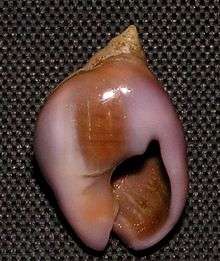Nassarius gibbosulus
| Nassarius gibbosulus | |
|---|---|
 | |
| Apertural view of a shell of Nassarius gibbosulus | |
| Scientific classification | |
| Kingdom: | Animalia |
| Phylum: | Mollusca |
| Class: | Gastropoda |
| (unranked): | clade Caenogastropoda clade Hypsogastropoda clade Neogastropoda |
| Superfamily: | Buccinoidea |
| Family: | Nassariidae |
| Subfamily: | Nassariinae |
| Genus: | Nassarius |
| Species: | N. gibbosulus |
| Binomial name | |
| Nassarius gibbosulus | |
| Synonyms[1] | |
|
list of synonyms
| |
Nassarius gibbosulus, common name the swollen nassa, is a species of sea snail, a marine gastropod mollusk in the family Nassariidae, the Nassa mud snails or dog whelks.[1]
Description
The length of the shell varies between 15 mm and 20 mm.
The thick shell is smooth, ovate, somewhat gibbous upon the back of the body whorl, flattened and widened upon the sides. The spire is short and acute. It is formed of five or six whorls. The aperture is ovate, smooth and white. The interior of the cavity is brown. The outer lip is margined without, smooth within, joining towards the top a large polished callosity, by which the columella and inferior surface of the whorls are entirely covered. The color is olive or of a brown fawn-color and ash, sprinkled with spots or clearer undulated lines. Sometimes one or two transverse brown bands surround the body whorl. The edge of the callosity is always of a more or less deep orange color.[2]
Distribution
This species occurs in the Eastern Mediterranean Sea off Greece, Lebanon, Syria and Egypt.
Use in prehistory
The oldest known jewelry in the world consists of two perforated beads made from shells of this species. These were discovered at Skhul in Israel, and were recently dated to between 100,000 and 135,000 years ago.[3][4] Similar ornaments (some made from Nassarius kraussianus and the bittersweet clam Glycymeris nummaria as well as Nassarius gibbosulus) have been discovered at a number of Middle Paleolithic sites and are considered a key piece of evidence for the theory that early anatomically modern humans in Africa and the Levant were more culturally sophisticated than had previously been thought.[5][6][7] In some cases the shells have been transported a considerable distance from the species' natural habitat. One example is the site of Oued Djebbana in Algeria, for example, where an N. gibbosulus bead has been found; this site was at least 190 km away from the sea at the time the shell was used there.[4]
References
- 1 2 Nassarius gibbosulus (Linnaeus, 1758). Retrieved through: World Register of Marine Species on 24 October 2012.
- ↑ Kiener (1840). General species and iconography of recent shells : comprising the Massena Museum, the collection of Lamarck, the collection of the Museum of Natural History, and the recent discoveries of travellers; Boston :W.D. Ticknor,1837 (described as Buccinum gibbosulum)
- ↑ Balter, M. (Jun 2006). "Archaeology. First jewelry? Old shell beads suggest early use of symbols". Science. 312 (5781): 1731. doi:10.1126/science.312.5781.1731. ISSN 0036-8075. PMID 16794051.
- 1 2 Vanhaereny, M.; d'Errico, F.; Stringer, C.; James, S. L.; Todd, J. A.; Mienis, H. K. (2006). "Middle Paleolithic Shell Beads in Israel and Algeria". Science. 312 (5781): 1785–1788. doi:10.1126/science.1128139. PMID 16794076.
- ↑ d'Errico, F.; Henshilwood, C.; Vanhaeren, M.; Van Niekerk, K. (2005). "Nassarius kraussianus shell beads from Blombos Cave: Evidence for symbolic behaviour in the Middle Stone Age". Journal of Human Evolution. 48 (1): 3–24. doi:10.1016/j.jhevol.2004.09.002. PMID 15656934.
- ↑ Bouzouggar, A.; Barton, N.; Vanhaeren, M.; d'Errico, F.; Collcutt, S.; Higham, T.; Hodge, E.; Parfitt, S.; Rhodes, E.; Schwenninger, J. -L.; Stringer, C.; Turner, E.; Ward, S.; Moutmir, A.; Stambouli, A. (2007). "82,000-year-old shell beads from North Africa and implications for the origins of modern human behavior". Proceedings of the National Academy of Sciences. 104 (24): 9964–9. doi:10.1073/pnas.0703877104. PMC 1891266. PMID 17548808.
- ↑ d'Errico, F.; Vanhaeren, M.; Barton, N.; Bouzouggar, A.; Mienis, H.; Richter, D.; Hublin, J. -J.; McPherron, S. P.; Lozouet, P. (2009). "Out of Africa: Modern Human Origins Special Feature: Additional evidence on the use of personal ornaments in the Middle Paleolithic of North Africa". Proceedings of the National Academy of Sciences. 106 (38): 16051–6. doi:10.1073/pnas.0903532106. PMC 2752514. PMID 19717433.
- Linnaeus C. von, 1758 :: stema Naturae. Editio decima. 1. Regnum Animale Holmiae, Laurentii Salvii iv + 824 p.
- Röding P. F., 1798: Museum Boltenianum sive Catalogus Cimeliorum e tribus regnis naturae quae olim collegerat Joa. Fried. Bolten M. D. p. d. pars secunda continens Conchylia sive Testacea univalvia, bivalvia et multivalvia pp. VIII + 199
- Cernohorsky W. O. (1984). Systematics of the family Nassariidae (Mollusca: Gastropoda). Bulletin of the Auckland Institute and Museum 14: 1-356.
- Puton E., 1856: Lettre au docteur Mougeot sur les Mollusques de Syrie, envoyés au musée des Vosges par M. le docteur Gaillardot; Annales de la Société d'Émulation du Département des Vosges p. 219-231
- Locard A., 1892: Les coquilles marines des côtes de France; Paris, J.B. Baillière & fils pp. 384.
- Pallary P., 1912a: Catalogue des mollusques du littoral méditerranéen de l'Egypte; Mémoires de l'Institut d'Egypte 7: 69-207, pl. 15-18
- Oliverio M. & Tringali L. (1992). Two sibling species of Nassariinae in the Mediterranean Sea (Prosobranchia, Muricidae, Nassariinae). Bollettino Malacologico 28(5-12): 157-160
- Gofas, S.; Le Renard, J.; Bouchet, P. (2001). Mollusca, in: Costello, M.J. et al. (Ed.) (2001). European register of marine species: a check-list of the marine species in Europe and a bibliography of guides to their identification. Collection Patrimoines Naturels, 50: pp. 180–213
External links
| Wikimedia Commons has media related to Nassarius gibbosulus. |